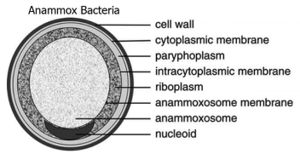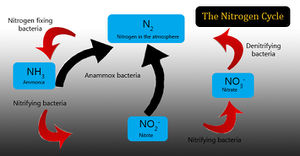Brocadia Anammoxidans
Scientific Classification

Domain: Bacteria
Phylum: Planctomycetes
Class: Planctomycetacia
Order: Planctomycetales
Family: Planctomycetaceae
Genus: Candidatus Brocadia
Introduction
Brocadia anammoxidans are anaerobic chemolithoautotrophic bacteria that belong to the order of Planctomycetes.[13] They are of special importance due to their capacity to perform the anammox (ANaerobic AMMonium OXidation) process, these bacteria were recently discovered to produce dinitrogen by removing reactive nitrogen species in marine systems.[5] Recent research being conducted in University of Nijmegen in the Netherlands has concluded that these are the only bacteria, known to date, that are able to produce hydrazine, used as rocket fuel, from waste products such as nitrite and ammonia.[10] Brocadia anammoxidans also play a leading role in removing ammonia from wastewater in the treatment process, one of its major biotechnological applications. Residing in several different environmental habitats including: arctic sea ice, fresh water, water columns and marine sediments; these bacteria have reshaped our understanding of nitrogen cycling (figure 2) and have colossal biofuel production potential and in other various applications.[1][5][12]

Discovery
For the past several decades, denitrification was considered to be one of the only processes responsible for the removal of ammonia from oceans.[1][10] In 1941, it was suggested that bacteria could use an anaerobic ammonium reaction for production and subsequent release of nitrogen gas.[5][11] However, it was not until 1990 that the first direct evidence for this process was found.[5] The Gist-Brocades yeast factory in Delft, Netherlands was devising a method to reduce their sulphide-rich waste and attempt to make their processes odorless.[4] Sulphide levels were expected to decrease and, according to dogma at the time, since ammonia required oxygen in order to be broken down, its concentration levels were expected to stay constant in an anaerobic reactor. The devised method worked as sulphide levels were decreasing, however, ammonia levels were surprisingly falling while nitrogen gas was being produced.[4] [6] Microbiologist Gijs Kuenen from Delft University of Technology was contacted and he suspected that anaerobic bacteria were combining ammonia with nitrite to form nitrogen gas and water. This marked the discovery of what his team named Brocadia anammoxidans ; anammoxidans for their unique biochemistry, and Brocadia for their place of discovery.[4] [6]
Cell Structure
A very unique feature of Brocadia anammoxidans is the presence of an anammoxosome (figure 1), a membrane-bound compartment where the anammox reaction takes place. Findings suggested that hydrazine, a toxic and potent rocket fuel, was being produced and stored in the anammoxosome. Although very puzzling for microbiologists at first, it was later hypothesized that high energy hydrazine may be required to drive the anammox reaction.[2] Research conducted on the cell's membrane by lipid expert Jaap Sinninghe Damsté explained how these bacteria managed their toxic load without killing themselves.[6] Damsté concluded that the lipids in the membrane were made from five carbon-based rings which fused together to form a "ladderane" lipid (figure 3). The high energy and instability of this structure was proposed to cause the membrane to become extremely dense, and therefore preventing hydrazine from leaking into the cell.[2]

Factors affecting anammox reaction in Brocadia anammoxidans
Some key factors affecting the activity of anaerobic ammonium oxidation include: temperature, oxygen conditions and water depth.[5] Brocadia anammoxidans have an optimum temperature which ranges from 12° C to 15° C. In comparison, denitrifying bacteria's optimum temperature ranges between 25° and 30° C.[8] The lower optimum temperature of Brocadia anammoxidans , allows them to out compete denitrifying bacteria in cold environments.[5][11] Anammox is restricted to anoxic conditions because in the presence of oxygen, ammonium is oxidized to nitrate (nitrification). Water depth is another key factor as increasing water depth leads to a decrease in anammox rates. This is due to the fact that the anammox reaction is directly related to the presence of NO2- , which is further dependent on the mineralisation of organic matter. Since the organic matter loading of sediments decreases with increasing water depth, so does the anammox rates.[5][8]
Applications
The most prevalent application of Brocadia anammoxidans lies in wastewater treatment, sewage plants, petroleum refineries and fertilizer manufacturing. These bacteria are used in breaking down the millions of litres of ammonia-rich waste that is produced. The conventional method of breaking down this ammonia-rich waste included converting ammonia into nitrite and nitrate using nitrifying bacteria, and then using denitrifying bacteria to yield nitrogen gas. The anammox reaction carried out by Brocadia anammoxidans provides huge advantages in comparison with this conventional method. The denitrifying bacteria in the conventional method require an energy source such as methanol, whereas anammox bacteria use ammonia as their fuel - and therefore there is no need for an energy source. Unlike the conventional method, anammox bacteria do not require oxygen, saving electricity that was used by machines to provide adequate oxygen levels in the conventional method. Furthermore, instead of producing CO2, anammox bacteria consume it - an environmentally friendly process.[5][6] Overall, this leads to an astonishing reduction of 90% in operational costs compared to the conventional method.[3]
References
(1) Brandes, J.A., Devol, A.H., and Deutsch, C. (2007) New developments in the marine nitrogen cycle. Chemical Reviews 107: 577-589.
(2) Elder,D.P., Snodin, D., Teasdale, A., (2001) Control and analysis of hydrazine, hydrazides and hydrazones—Genotoxic impurities in active pharmaceutical ingredients (APIs) and drug products, Journal of Pharmaceutical and Biomedical Analysis 54:900-910.
(3) Jetten, M.S.M., Cirpus, I., Kartal, B., van Niftrik, L., van de Pas-Schoonen, K.T., Sliekers, O. et al. (2005) 1994-2004: 10 years of research on the anaerobic oxidation of ammonium. Biochemical Society Transactions 33: 119-123.
(4) Kuenen, J.G., Anammox bacteria: from discovery to application. Nature Reviews Microbiology 64: 320 (2008).
(5) Martin, H., Anaerobic Ammonium Oxidation (Anammox) – A new sink in the marine nitrogen cycle. ETH Zurich, (2008).
(6) Pilcher, S., Microbiology: Pipe Dreams. Nature Publishing Group 437: 1227-1228 (2005).
(7) Rysgaard, S., Glud, R.N., Risgaard-Petersen, N., Dalsgaard, T., and Jt (2004b) Denitrification and anammox activity in Arctic marine sediments. Limnology and Oceanography 49: 1493-1502.
(8) Saad, O., Conrad, R., and Kg (1993) TEMPERATURE-DEPENDENCE OF NITRIFICATION, DENITRIFICATION, AND TURNOVER OF NITRIC-OXIDE IN DIFFERENT SOILS. Biology and Fertility of Soils 15: 21-27.
(9) Schubert, C.J., Durisch-Kaiser, E., Wehrli, B., Thamdrup, B., Lam, P., and Kuypers, M.M.M. (2006) Anaerobic ammonium oxidation in a tropical freshwater system (Lake Tanganyika). Environmental Microbiology 8: 1857-1863.
(10) Stefan,H., Aller, R., Canfield,D.E.,Dalsgaard (2005)Nitrogen removal in marine environments: recent findings and future research challenges, Marine Chemistry 94: 125-145.
(11) Strous, M., Van Gerven, E., Kuenen, J. G. & Jetten, M. Effects of aerobic and microaerobic conditions on anaerobic ammonium-oxidizing (Anammox) sludge. Appl. Environ. Microbiol. 63: 2446-2448 (1997).
(12) Trimmer, M., Nicholls, J.C., and Deflandre, B. (2003) Anaerobic ammonium oxidation measured in sediments along the Thames estuary, United Kingdom. Applied and Environmental Microbiology 69: 6447-6454.
(13) Van Niftrik, L.A., Fuerst, J.A., Damste, J.S.S., Kuenen, J.G., Jetten, M.S.M., Strous, M., and Ik (2004) The anammoxosome: an intracytoplasmic compartment in anammox bacteria. Fems Microbiology Letters 233: 7-13.
